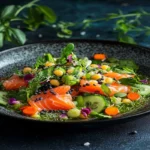Description
This article provides a comprehensive guide to creating homemade fish food, emphasizing its nutritional benefits, cost-effectiveness, and customization potential. It highlights the importance of tailoring meals to meet the specific dietary needs of different fish species, ensuring optimal health and longevity. The article includes detailed recipes, preparation steps, and tips for feeding, as well as advice on monitoring fish health and adjusting diets accordingly. Additionally, it discusses the advantages of using fresh ingredients over commercial options and offers practical storage solutions for homemade fish food
Ingredients
- Animal-Based Proteins:
- Fish fillets (e.g., haddock, salmon)
- Shrimp
- Squid
- Antarctic krill
- Vegetable Additions:
- Peas
- Zucchini
- Algae wafers
- Spinach
- Supplements and Additives:
- Omega-3 fatty acids
- Vitamins
- Gelatin (for binding)
Instructions
- Gathering Ingredients:
- Choose high-quality proteins like fish or shrimp.
- Add vegetables such as spinach or peas.
- Preparation Steps:
- Chop ingredients into small pieces for easier blending.
- Blend proteins, vegetables, and supplements into a smooth paste.
- Add gelatin to help the mixture stick together.
- Molding and Freezing:
- Pour the mixture into molds or containers.
- Chill in the fridge to set.
- Freeze for long-term storage.
Notes
- Tailor the ingredients based on the dietary needs of your fish species (carnivores, herbivores, omnivores).
- Use gelatin to bind the food, making it easy to portion and feed.
- Monitor fish behavior and adjust portion sizes to prevent overfeeding and water pollution.
- Store frozen fish food in airtight containers for up to 12 months.
- Prep Time: 15MIN
- Cook Time: 30min
- Category: Fish Care, Nutrition
- Method: Blending, Freezing
- Cuisine: N/A (General Fish Food Recipe)
Nutrition
- Serving Size: Varies based on fish species and size
- Calories: Depends on ingredients used
- Sugar: MINIMAL
- Sodium: Minimal
- Fat: Varies based on protein sources
- Saturated Fat: Minimal
- Unsaturated Fat: High (from omega-3 fatty acids)
- Trans Fat: 0gr
- Carbohydrates: Varies based on vegetable content
- Fiber: High (from vegetables)
- Protein: High (from animal-based proteins)
- Cholesterol: Not specified
Keywords: Homemade Fish Food, Aquarium Nutrition, Fish Diet, Custom Fish Food
